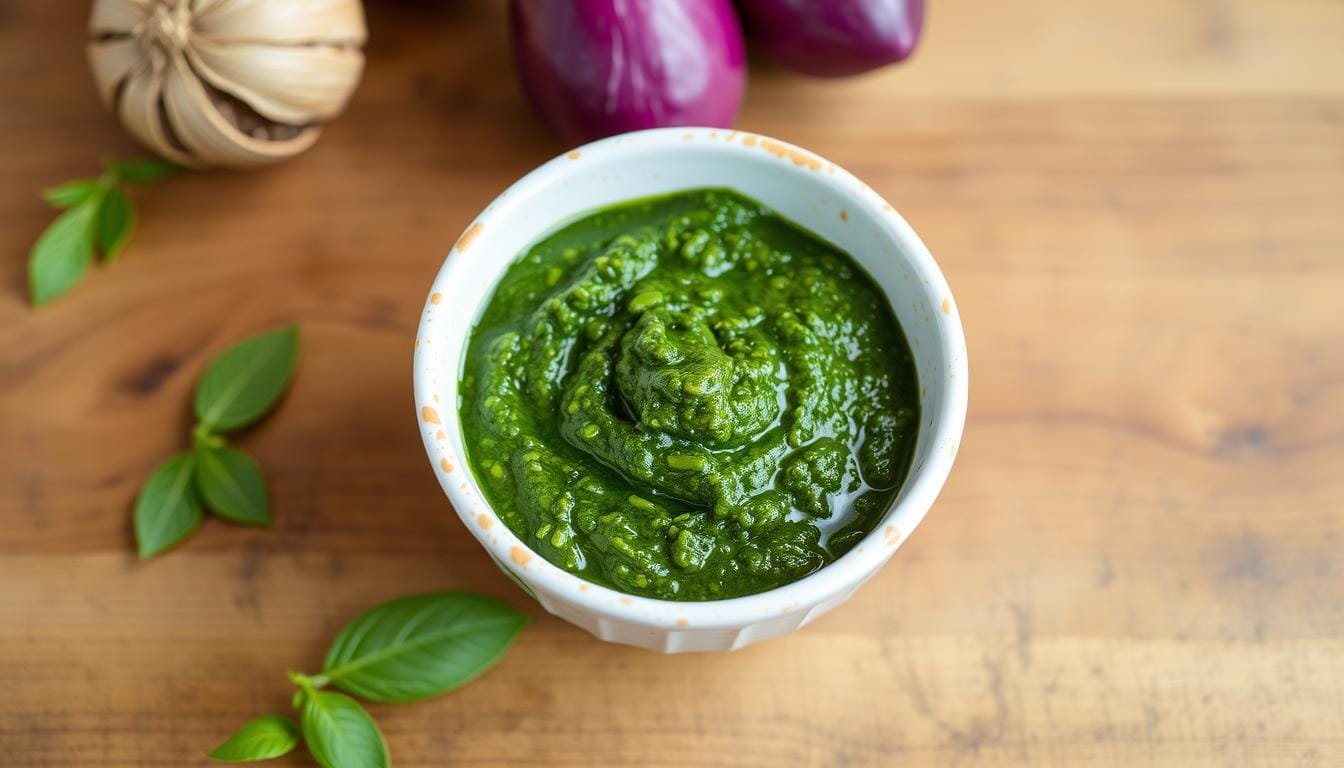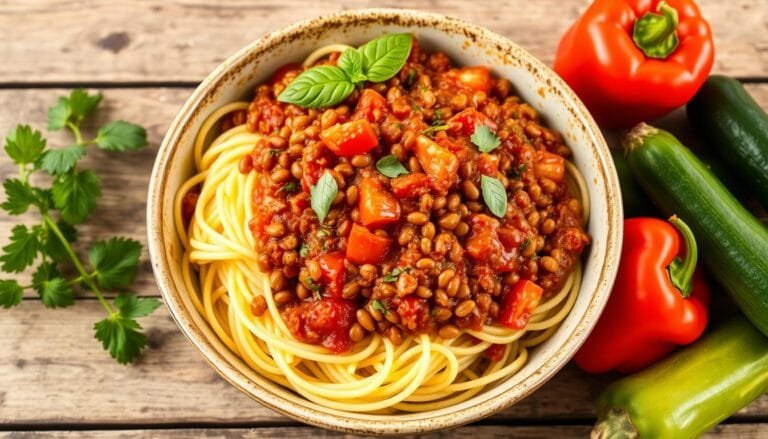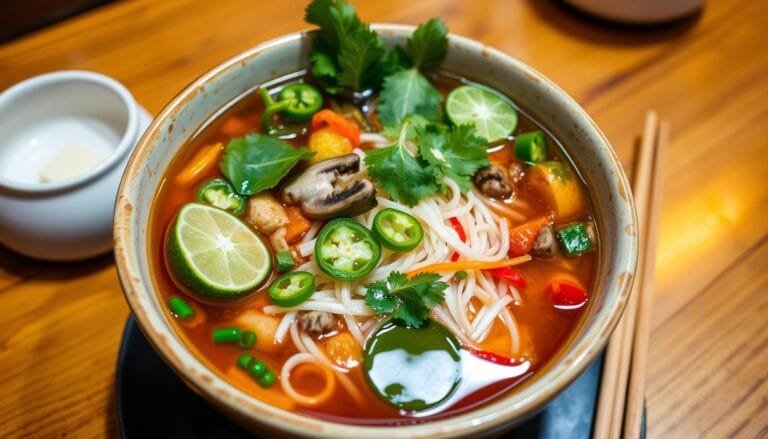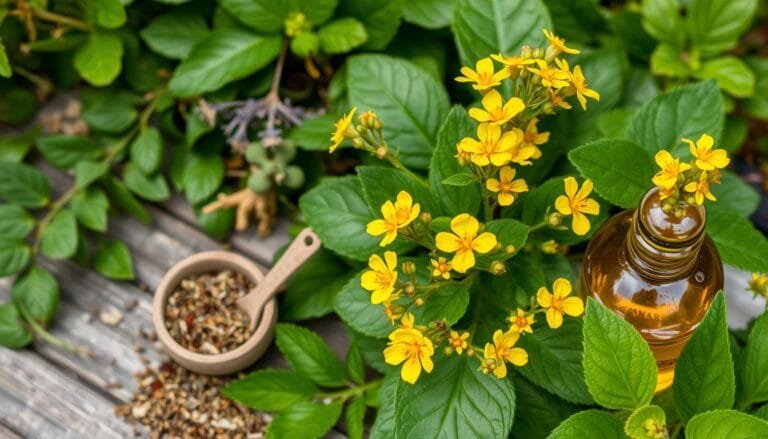I’m excited to share my recipe for dairy-free, plant-based pesto. It’s full of fresh, vibrant flavors. This homemade vegan pesto with basil is easy to make. It’s also a versatile sauce that can make many dishes better, like pasta, sandwiches, and salads.
This pesto is different from traditional pesto because it doesn’t have Parmesan cheese. Instead, it uses a mix of healthy ingredients. These ingredients give it the same rich, nutty, and garlicky taste you love. Making this creamy, dairy-free pesto is simple. It’s great for those who follow gluten-free, Paleo, Whole30, or keto diets.
What Makes This Vegan Pesto Recipe Special
This vegan pesto recipe is special because it uses lemon juice. It balances the richness of olive oil and brings out fresh, garlicky, and nutty flavors. Without cheese, it’s lighter but just as flavorful, thanks to top-notch ingredients.
Unlike traditional Genoese basil pesto, this version doesn’t use Parmesan cheese. It’s great for those who can’t or don’t want to eat dairy. The lemon juice adds a bright, zesty taste that goes well with the earthy basil and nutty pine nuts.
This dairy-free pesto recipe is versatile and quick to make. It’s perfect for pasta, zucchini noodles, salad dressings, and grain bowls. It adds a burst of flavor to any meal.
You can also customize this lemon in pesto recipe to your liking. Try using arugula or kale instead of basil. Use walnuts or almonds instead of pine nuts. Adjust the nutritional yeast for a cheesy taste. The options are endless, making it a must-have in your kitchen.
“This vegan pesto is a game-changer! The lemon juice adds such a refreshing brightness that perfectly balances the richness of the olive oil. It’s become a weekly staple in my kitchen.”
Essential Ingredients for Perfect Vegan Pesto with Basil
Creating a great vegan pesto starts with choosing the best ingredients. Fresh basil leaves add a sweet and peppery taste. Pine nuts give a buttery texture. Each part is key to a perfect flavor.
Fresh Basil and Its Role
The heart of this pesto is 2 cups of fresh basil leaves. This herb brings a mix of sweet and spicy flavors. It also makes the pesto look vibrant and appealing.
Pine Nuts and Alternatives
Pine nuts are classic for pesto, adding a rich texture. But for vegan pesto, we offer walnuts, pistachios, or pepitas as alternatives. These options add a twist and are safe for those with nut allergies.
Quality Olive Oil Selection
The olive oil used is very important. It should be extra virgin for the best taste and aroma. Its fruity and peppery notes will enhance the pesto’s flavor.
With the right ingredients, your vegan pesto will look great and taste amazing. Use it on pasta, toast, or as a marinade. It will make your dishes better.
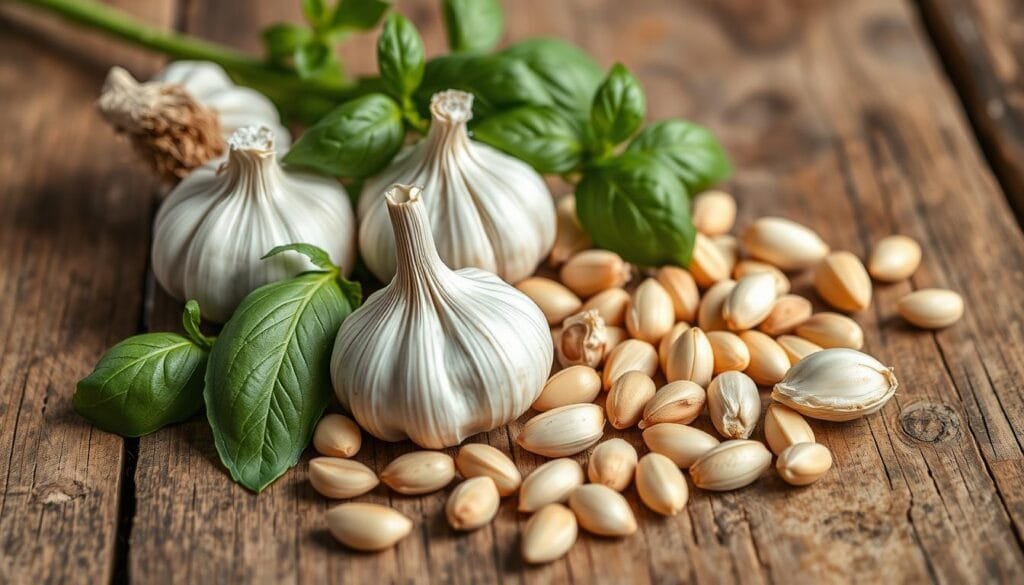
The Secret to Keeping Your Pesto Vibrant Green
Keeping your homemade pesto green is important for its look and taste. The key is to use fresh, in-season basil. Blanching the basil in boiling water for 5-15 seconds helps. Then, cool it in an ice bath to keep it green. This method might make the basil less aromatic.
To stop pesto from turning brown, cover it with extra virgin olive oil. This thin layer slows down the oxidation. It keeps the basil leaves from turning brown too quickly.
The quality of your basil affects how long it stays green. Use these tips to enjoy your pesto’s vibrant color for longer. A few simple steps can make a big difference.
“The secret to keeping pesto green is to use the freshest, in-season basil possible and take steps to prevent oxidation.”
Step-by-Step Preparation Method
Making homemade vegan pesto is simpler than you think. Let’s go through the steps to get the perfect pesto. Each ingredient needs proper preparation for great flavors and texture.
Toasting the Nuts
Begin by toasting your nuts, like pine nuts or cashews, in a dry skillet. Heat it on medium and stir often until they smell nice and are lightly brown. This step makes them taste nuttier and adds depth to your vegan pesto.
Processing Techniques
Now, add the toasted nuts and garlic to a food processor. Pulse until they’re finely chopped. Then, mix in fresh basil leaves, lemon zest, lemon juice, salt, and pepper. Blend until it’s a thick, paste-like pesto preparation.
Achieving the Perfect Consistency
With the pesto base ready, slowly add olive oil while blending. Keep blending until it’s thick and saucy, not too runny. For a smoother pesto, chop garlic and nuts before adding them.
To keep your pesto green, blend gently. This helps keep the basil’s flavor and color. If it’s too thick, add a bit of water or oil.
Follow these steps to make delicious homemade vegan pesto. Use it with pasta, on sandwiches, or as a veggie dip.
Creative Recipe Variations and Substitutions
Homemade pesto offers endless possibilities! The classic basil pesto is tasty, but feel free to try new herbs, nuts, and ingredients. This vegan pesto recipe is a great starting point. With a few tweaks, you can make many different pestos.
Try using cilantro, parsley, or mint instead of basil for a fresh twist. You can also add greens like kale, arugula, or carrot tops for extra nutrition and color. Walnuts, pistachios, cashews, or almonds are great substitutes for pine nuts.
For a nut-free option, pepitas (pumpkin seeds) or sunflower seeds are perfect. A Southeast Asian pesto can be made with cilantro, mint, peanuts, ginger, and lime. Carrot top pesto is another tasty way to use up your produce.
The secret to great pesto is using herbs, nuts/seeds, garlic, oil, and seasonings. Feel free to change the ingredients to suit your taste and what’s in season. The world of pesto is your playground!
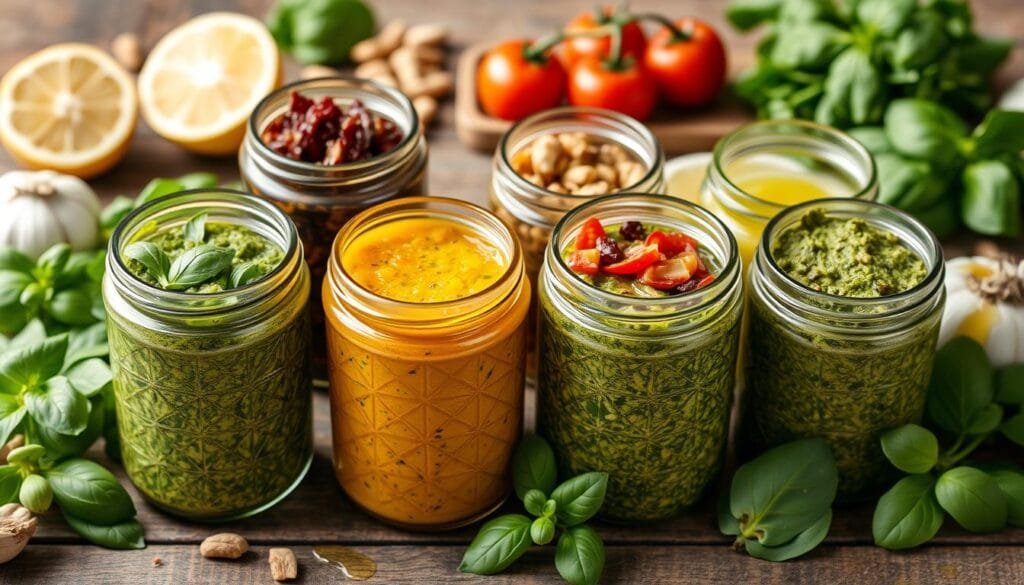
Storage Tips and Preservation Methods
Keeping your homemade vegan pesto fresh and flavorful is important. I’ll share tips on storing it in the fridge or freezer. These methods will help you enjoy your pesto for longer.
Refrigeration Guidelines
Store fresh pesto in an airtight container in the fridge for 3 to 4 days. To keep it fresh, cover it with a thin layer of olive oil before sealing. This layer protects it from air and keeps the store vegan pesto vibrant and tasty.
Freezing Instructions
Freezing is great for longer storage. Spoon pesto into ice cube trays and freeze. Then, move the pesto cubes to a freezer-safe bag or container. This way, you can thaw only what you need, whenever you want.
Frozen pesto can stay good for up to 2 months. When you’re ready to use it, thaw the amount you need in the fridge. After thawing, stir well to mix any separated parts. Now, your pesto is ready to use in pasta, sandwiches, or recipes.
Delicious Ways to Use Your Vegan Pesto
Vegan pesto is a versatile condiment that can make many dishes better. It adds fresh basil flavor or a creamy, nutty taste. It’s a great thing to have in your kitchen.
Here are some tasty ways to use your vegan pesto:
- As a pasta sauce – Toss it with your favorite cooked pasta or zucchini noodles for a quick and flavorful meal.
- On sandwiches and avocado toast – Spread it on bread, bagels, or smashed avocado for a tasty twist.
- In salad dressings – Blend it into olive oil and vinegar for a vibrant, pesto-infused vinaigrette.
- As a topping for roasted vegetables – Dollop it on top of roasted broccoli, cauliflower, or Brussels sprouts.
- On pizza – Use it as a sauce or drizzle it over the top of your favorite vegan pizza creations.
- As a dip for crusty bread or fresh veggies – Serve it alongside toasted baguette slices or crunchy carrot and celery sticks.
- In grain bowls – Mix it into cooked quinoa, rice, or farro for a flavor-packed base.
- As a marinade for tofu or tempeh – Let your plant-based proteins soak up the pesto’s vibrant flavors.
- Stirred into soups – Add a spoonful of pesto to enhance the taste of vegetable, lentil, or bean-based soups.
- In homemade hummus – Blend it into your favorite hummus recipe for a unique, pesto-infused dip.
There are endless ways to use vegan pesto. Try new pairings, swap it for traditional basil pesto, or make pesto variations like wild garlic or kale. Its fresh, bold flavor makes it a must-have in your kitchen.
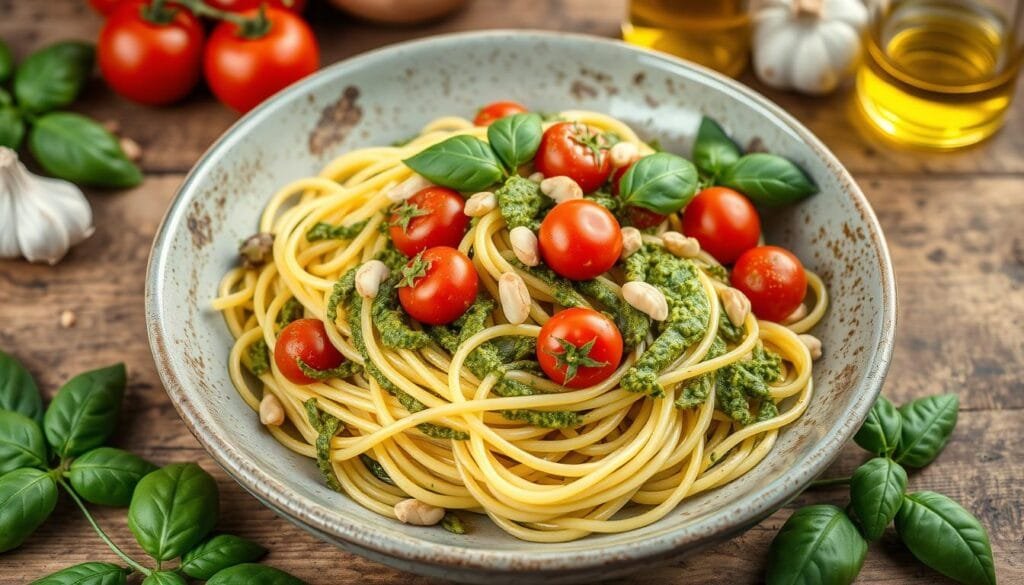
Nutritional Benefits and Dietary Information
Vegan pesto is full of good stuff that makes it great for you. It starts with fresh basil, which is packed with vitamins K and A. It also has anti-inflammatory properties that help keep you healthy.
Pine nuts or other nuts and seeds add healthy fats, protein, and minerals. These are all important for your body to function well.
High-quality olive oil in the pesto is good for your heart. It has monounsaturated fats and antioxidants. These can help lower cholesterol and blood pressure.
Garlic in the pesto might boost your immune system. This makes it a nutritional powerhouse.
This vegan pesto is cheese-free, which is good for those who avoid dairy. But, it’s high in oil, so eat it in moderation. This helps keep your diet balanced.
This pesto is also gluten-free. It’s perfect for people with dietary restrictions. Its versatility makes it a great addition to any meal.
| Nutrient | Amount per 1/4 cup (63g) serving |
|---|---|
| Calories | 263 |
| Protein | 6g |
| Fat | 24g |
| Saturated Fat | 4g |
| Carbohydrates | 6g |
| Fiber | 1g |
| Sugar | 4g |
| Sodium | 380mg |
| Calcium | 193mg |
The nutritional value of pesto can change based on ingredients and portion size. Making your own vegan pesto lets you control salt and try new flavors. This way, you can make it fit your dietary needs.
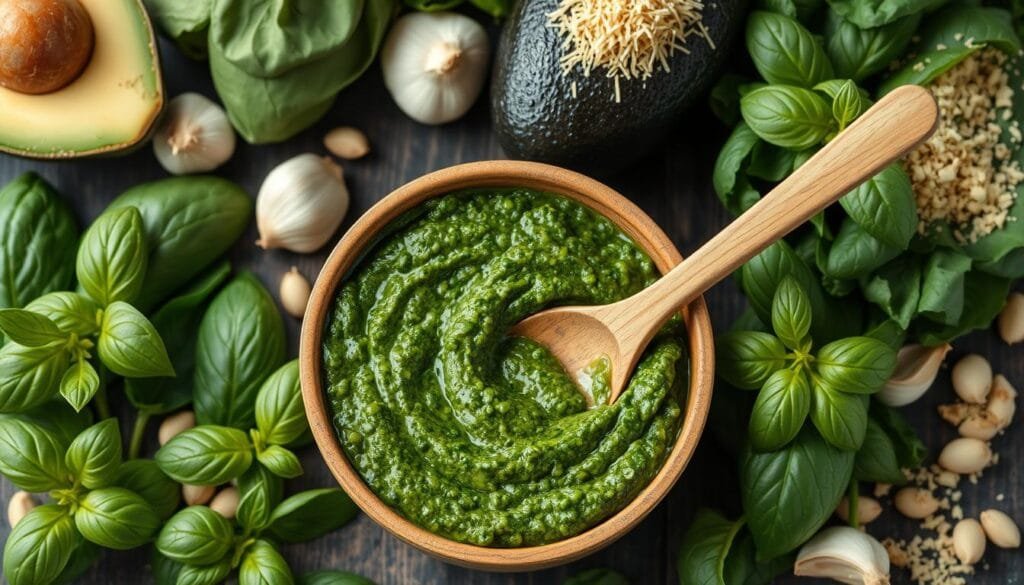
Troubleshooting Common Pesto-Making Challenges
Making the perfect vegan pesto can be tricky, but I’ve got tips to help. If it’s too bitter, try using spinach or arugula instead. For a thicker pesto, add a bit of olive oil or water.
If it’s too thin, add more nuts or greens. Roasting garlic before blending can also help if it’s too strong. Make sure to blend everything well to avoid separation.
To keep the color bright, blanch the basil or squeeze some lemon juice. For a smooth pesto, grind the nuts finely before adding the rest. With these tips, your vegan pesto will be perfect every time.
